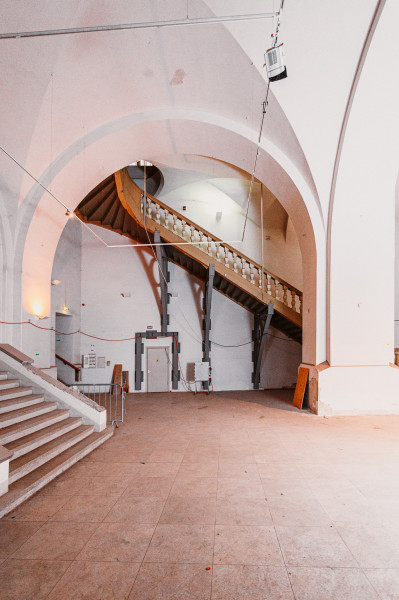








Under the management of SJSC “State Real Estate” (SRE), the renovation works of the interior of the “Arsenāls” exhibition hall of the Latvian National Museum of Art (LNMA) have started. During the reconstruction, combining the values of the past with modern technologies, the premises will be modernised for the exhibition of art works, while preserving the authenticity of the building and improving its functionality, informs Jeļena Gavrilova, Member of the Board of SRE.
According to the schedule, dismantling works are currently underway and a digital model of the existing construction design documentation is being developed using the BIM methodology and making minor improvements to the construction design solutions previously developed by GP “AD SPATIUM”. The contract for the construction works has been concluded with GP "P un S Būvniecība" for a contract price of EUR 12,860,293.36 excluding VAT (VAT EUR 2,700,661.61). Construction works are expected to be completed by the end of 2027. The project has a total funding of EUR 17,744,108.06 including VAT, of which EUR 15,082,491.85 comes from the EU funding.
"The historic warehouse building richly reflects Latvia's artistic and architectural heritage. The planned renovation also includes the restoration of the unique architectural elements of Arsenāls, for example, the old wooden staircase. At the same time, modern energy-efficient ventilation and climate control systems will be installed, which will create suitable conditions for exhibiting and storing artworks, ensuring comfort for both visitors and employees," says Jeļena Gavrilova, Member of the Board of SRE.
"We and the entire visual arts community are looking forward with great anticipation to the opening of the Arsenāls after the reconstruction. For the work to proceed smoothly and successfully, dedicated and professional cooperation between all parties involved is essential. The museum's experts have already started to prepare for the moment when Arsenāls will become home to a diverse programme of exhibitions and events. The historic building, once restored, will be an accessible cultural space that will serve the public and invite everyone to explore and experience art, creativity and cultural diversity," says Māra Lāce, Director of the LNMA.
According to the construction project, restoration works are to be carried out, as well as reconstruction of the building's load-bearing structures, including the roof, partitions, basement, and other interior decoration works, construction of engineering networks, including ventilation, heating, climate control, power supply, low voltage, control and automation systems, sound system, security alarm, electronic communication networks, as well as video surveillance. The redeveloped premises will be adapted to a variety of exhibitions and events, thus ensuring flexible and versatile use. The premises will be improved to comply with building regulations and create optimal conditions for the safe storage and quality display of the artwork. All historic entrances and staircases will be preserved. The steps of the four stairs, which are not in functional use, are to be fitted with wooden seating surfaces.
To improve accessibility, the project also includes the reconstruction of Torņa Street from Jēkaba Street to Arsenāla Street, including the connection of the external rainwater system to the central rainwater drainage system, as well as the improvement of the side yard between the Saeima and Arsenāls buildings with concrete paving stones. Reconstruction works of Torņa Street will promote improvement of the quality of roads and pavements, making access to the exhibition hall more convenient and safer for all visitors.
The Arsenāls Exhibition Hall reconstruction and restoration project will be financed by Measure 5.1.1.5 “Restoring Unique European Cultural Heritage to Enhance Accessibility Through the Development of Cultural Services” of the Specific Objective 5.1.1 “Promoting Integrated Social, Economic, and Environmental Development of the Local Territory and Cultural Heritage, Tourism, and Safety in the Functional Areas of Cities” of the European Union Cohesion Policy Programme for 2021–2027.
The Arsenāls Exhibition Hall is an example of architectural classicism and the renovation project is part of the regulatory framework promoted by the Ministry of Culture for the preservation of unique cultural monuments of national significance located in the urban planning monument, i.e. the Historic Centre of the City of Riga, and also within the territory of UNESCO World Culture and Nature Heritage Site – the Historic Centre of Riga. The project envisages the development of five locations in the historic centre of Riga, i.e. the Great Guild, the Arsenāls Exhibition Hall, Vaļņu Street and the surroundings thereof, Daugava Gate, and also to create expositions of the National History Museum of Latvia in Riga Castle.
About Arsenāls Exhibition Hall
The Arsenāls Exhibition Hall of the Latvian National Museum of Art is located inside an important architectural monument: a customs warehouse building, or arsenal, built in the early 19th century, in the late Russian classicism style, functionally adapted as a museum. The building was originally designed by architect Johann Eduard de Witte. A little later, the design was expanded with suggestions by Julius Adolph Spazier; in 1828, St Petersburg architect Alexander Nellinger and customs department architect Ivan Lucchini prepared the final version, and in November 1832, the official commissioning of the building took place. The Arsenāls building was used as a warehouse throughout its history. It 1920–1930, it accommodated the personal belongings of members of the military. After the Second World War, a department of the Soviet Army used it for storing goods and supplies; it was also used by a military school. In the mid-1980ies, the building was taken over by the Ministry of Culture, which handed it over for the creation of a museum there. On 1 January 1989, after the relocation of the second half of the 20th century art collection from a building in Krišjāņa Valdemāra Street, the Arsenāls art museum opened its doors.

